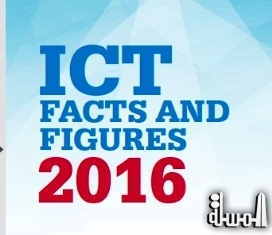
ITU releases 2016 ICT figures
ICT services getting more affordable – but more than half the world’s population still not using the Internet
aTP- Arab tourism portal News – Geneva,– New data released today by ITU, the UN specialized agency for information and communication technology (ICT), show that 3.9 billion people remain cut-off from the vast resources available on the Internet, despite falling prices for ICT services.
ICT Facts & Figures 2016 shows that developing countries now account for the vast majority of Internet users, with 2.5 billion users compared with one billion in developed countries.
But Internet penetration rates tell a different story, with 81% in developed countries, compared with 40% in developing countries and 15% in the Least Developed Countries.
“Access to information and communication technologies, particularly broadband, has the potential to serve as a major accelerator of the 2030 Agenda for Sustainable Development.
Global interconnectedness is rapidly expanding, however more needs to be done to bridge the digital divide and bring the more than half of the global population not using the Internet into the digital economy,” said ITU Secretary-General Houlin Zhao.
“2016 marks the year when the international community is embarking on the implementation of the 17 Sustainable Development Goals (SDGs) and their 169 targets. ITU, given the tremendous development of ICTs, has a key role to play in facilitating their attainment,” says Brahima Sanou, the Director of the ITU’s Telecommunication Development Bureau.
“ITU statistics inform public and private-sector decision makers, and help us accomplish our mission: to make use of the full potential of ICTs for the timely achievement of the SDGs.”
Mobile broadband growth slowing
The new edition of ITU’s ICT Facts & Figures reveals that mobile phone coverage is now near-ubiquitous, with an estimated 95% of the global population – or some seven billion people – living in an area covered by a basic 2G mobile-cellular network.
Advanced mobile-broadband networks (LTE) have spread quickly over the last three years and reach almost four billion people today – corresponding to 53% of the global population. But while the number of mobile-broadband subscriptions continues to grow at double digit rates in developing countries to reach a penetration rate of close to 41%, mobile-broadband penetration growth has slowed overall. Globally, the total number of mobile-broadband subscriptions is expected to reach 3.6 billion by end 2016, compared with 3.2 billion at end 2015.
Fixed broadband growth strongest in developed countries
Global fixed-broadband subscriptions are expected to reach around 12 per 100 inhabitants in 2016, with Europe, the Americas and the Commonwealth of Independent States regions having the highest rates of penetration. Strong growth in China is driving fixed-broadband in Asia and the Pacific, where penetration is expected to surpass 10% by end of 2016.
ICT prices continue to fall
Mobile-broadband services have now become more affordable than fixed-broadband services, with the average price for a basic fixed-broadband plan more than twice as high as the average price of a comparable mobile-broadband plan.
By the end of 2015, 83 developing countries had achieved the Broadband Commission’s affordability target.
Digital divide means half the world is still offline
By the end of 2016, more than half of the world’s population – 3.9 billion people – will not yet be using the Internet. While almost one billion households in the world now have Internet access (of which 230 million are in China, 60 million in India and 20 million in the world’s 48 Least Developed Countries), figures for household access reveal the extent of the digital divide, with 84% of households connected in Europe, compared with 15.4% in the African region.
Global online gender gap widens
Internet penetration rates are higher for men than for women in all regions of the world. The global Internet user gender gap grew from 11% in 2013 to 12% in 2016. The regional gender gap is largest in Africa, at 23%, and smallest in the Americas, at 2%.
Internet bandwidth
By early 2016, international Internet bandwidth had reached 185,000 gigabits per second, up from a low of 30,000 gigabits in 2008. However, bandwidth is unequally distributed globally, and lack of bandwidth remains a major bottleneck to improved Internet connectivity in many developing and Least Developed Countries.








